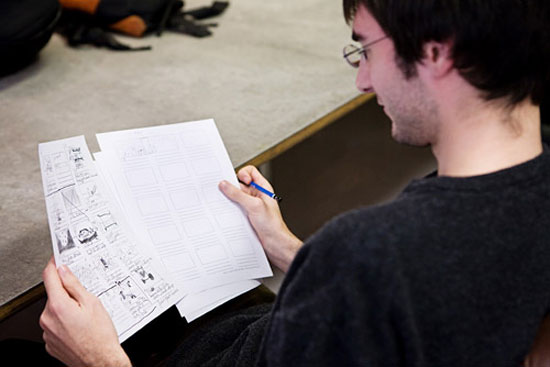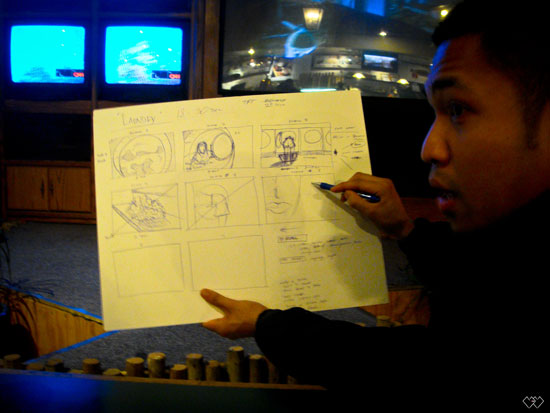Author: Geetesh Bajaj
Storyboarding - An Introduction
Paper or Screen?
Paper Alternatives
Continued on Page 2
A presentation without a storyboard is like a cart without a horse. You have no idea which direction whomsoever is going to pull the cart. And when you realize your mistake, it may be too late. And it is at this note that our storyboarding story unfolds.
Storyboarding is never the beginning of any creative project, because you cannot get to this intermediate stage unless your concept and vision are completely clear. If you are undertaking a project for yourself or for a client, there would be little to be gained in undertaking a storyboarding session without ideas - the storyboard is an element to capture and refine ideas, not to create them. If you do not have any great ideas, think about brainstorming rather than storyboarding!
What exactly is a storyboard? Is it a piece of paper or a part of your computer screen? Is it that part of your mind where you store the sequence of your creativity? Actually, its all of them - the 'storyboard' is both abstract and physical - in our thoughts and on papyrus. The abstract is its very existence, but it's the physical one which is a retrievable record of its brilliance.

Storyboards capture ideas
Photo Credit: Vancouver
Film School
by Creative Commons
If you're creating your first formal storyboard, you'll have to decide if you require paper or screen. Both of them have their advantages and disadvantages - and both come in so many types that you can have a great time deciding which works best for you.
A paper storyboard is something that's more akin to our psychology - it's no wonder so many screen alternatives try to emulate paper. There could be nothing easier than putting a pencil or pen onto paper and scribbling notes, drawing a prototype or creating a flow chart. You can also manage your schedule, ascertain your priorities and do more. It's no secret that paper is more close to a human being's comfort level - lots of people are still wary of digital storyboards, after all the mouse or keyboard is not something with which you can cut and write or write between the lines. Things are however changing, or have already changed, as we shall soon examine.
New technologies are in the fore today - a tablet or pen emulates a regular pen, and it comes with a convenient electronic eraser to boot -- imagine doing that the conventional way. And you could use a speech recognition program to input ideas straight into your electronic storyboard. Handwriting recognition and OCR programs can port all your existing paper storyboards onto the screen level as well.
Screen storyboards have other advantages too - you can share them over your network or the Internet, also you can store them on a USB drive or a shared Internet cloud drive.
By sharing in myriad ways, your storyboards become more collaborative, and consequently your content is richer, your ideas are originated from a higher base level. This does not mean that paper storyboards are without benefits - not everybody carries a tablet or a laptop everywhere - paper is everywhere: on newspapers, napkins and notes - just find an area to write, and scribble your thoughts away. It is necessary to mention here that it is better to carry a small paper notepad to capture your sudden or planned spurts of inspirations - all loose papers can be lost very easily: they could fly away from your window!

Paper storyboards are very effective
Photo Credit: Bobbi Vie by
Creative Commons
What's a paper storyboard? Any piece of paper is technically fit enough to be a storyboard. But paper in many ways belies the very function of a storyboard - 'permanence'. Granted, there is no such thing called 'permanent' on earth, but paper's permanence levels are directly related to its form. A notebook is more permanent than a loose sheet. In fact the notebook could be more permanent than a USB drive or a CD. However, your computer's hard disk or storing it on the Internet is even more permanent than that.
The single biggest advantage of a screen (also called digital and electronic throughout this article) storyboard is duplication. That's why I don't advise you to use paper. For that matter, I don't think that the screen alternative on its own is a good idea too. So, what do we use? Simple, we use a combination - by all means use paper, but convert it to electronic format as soon as possible.
We just saw how we can use paper to create a better screen storyboard - in the same way we can use screen to create a better paper storyboard. You can create a template in your word processor, which you can then print out in certain quantities. These papers can be stapled or spiralled to form a nice notepad. Use this as your storyboard - just remember to put it all back in the electronic format at due intervals.
Microsoft and the Office logo are trademarks or registered trademarks of Microsoft Corporation in the United States and/or other countries.